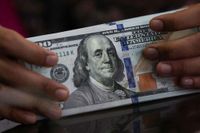Oil prices took a tumble on Friday, August 15, 2025, as global markets fixated on an anticipated summit between U.S. President Donald Trump and Russian President Vladimir Putin in Alaska, where the prospect of a Ukraine ceasefire and potential easing of sanctions on Moscow loomed large. Brent crude futures slipped by $0.32, or 0.48%, to $66.52 per barrel, while West Texas Intermediate (WTI) crude dropped $0.45, or 0.70%, to $63.51 per barrel by late afternoon, according to Mettis Link News. Other sources, including Strat News Global, reported Brent falling as much as 50 cents, or 0.8%, to $66.34 a barrel by 09:23 GMT, with WTI down 57 cents, or 0.9%, to $63.39.
At the heart of the market’s jitters was the high-stakes meeting in Alaska, where a potential Ukraine ceasefire was set to dominate the agenda. President Trump, expressing optimism, declared that he believed Russia was prepared to end the conflict. However, he didn’t shy away from warning that if peace talks faltered, the U.S. could impose secondary sanctions on countries still buying Russian oil. As Trump put it, peace would require at least a second meeting involving Ukraine’s leader, tempering hopes for a swift resolution, according to Global Banking and Finance Review.
Market analysts were quick to weigh in on the uncertainty. Giovanni Staunovo, a commodity analyst at UBS, explained, “The market is focused on whether a ceasefire materializes. A ceasefire would imply higher Russian output.” He added, “The real question is whether we see escalation or de-escalation.” Even if an agreement is reached, Staunovo noted that lifting U.S. sanctions on Russia would be a drawn-out process, requiring congressional approval. The sentiment was echoed by Strat News Global, which highlighted that any deal would likely take time to translate into concrete changes for Russian oil exports.
For the week ending August 15, 2025, WTI crude was on track for a 0.7% decline, while Brent crude looked set to eke out a 0.4% gain. These figures reflected the market’s cautious optimism, with traders hedging their bets on the outcome of the Trump-Putin talks.
Yet, the oil market’s woes weren’t limited to geopolitics alone. Economic data out of China added another layer of complexity. Official figures revealed that factory output growth in July had slowed to its weakest pace in eight months, while retail sales growth was the slowest since December. Despite Chinese refineries processing 8.9% more crude year-on-year in July, throughput actually dropped from June’s nine-month high, and a rise in oil product exports suggested that domestic consumption was softer than anticipated. As Strat News Global put it, “Chinese government data showed factory output growth slumped to an eight-month low and retail sales growth expanded at its slowest pace since December, weighing on sentiment despite stronger oil throughput in the world’s second-largest crude user.”
These concerns over Chinese demand were compounded by forecasts of a widening oil market surplus. Bank of America analysts, in a Thursday note cited by both Mettis Link News and Strat News Global, projected an average surplus of 890,000 barrels per day from July 2025 through June 2026, attributing this to increased supply from OPEC+, a group that includes the Organization of the Petroleum Exporting Countries, Russia, and their allies. This forecast followed a warning from the International Energy Agency earlier in the week, which cautioned that the oil market appeared “bloated” after OPEC+ output hikes.
Meanwhile, the currency and bond markets were also in flux. The U.S. dollar slipped on Friday as investors braced for import price data and eyed the Trump-Putin meeting. According to Lam Seng Fatt, the yen outperformed both the euro and the pound following a surprising surge in Japanese GDP growth for the second quarter, which showed export volumes holding up well despite new U.S. tariffs. The Japanese yen rose 0.4% against the dollar to 147.20, while the euro climbed 0.25% to $1.1675, and the pound edged up 0.20% to $1.3553. The Australian dollar also gained 0.2% to $0.6508, while the Chinese yuan pulled back from a two-week high on weaker-than-expected economic readings.
Analysts suggested that the euro could benefit from any ceasefire deal in Ukraine. Francesco Pesole, a forex strategist at ING, commented, “The Trump-Putin meeting and any better clarity on the path ahead in the Ukraine conflict have longer-lasting implications for the euro than for the dollar.” He added, “There is a chance that today might be the first step in the direction of de-escalation, and markets may tread carefully for now.”
Back in the U.S., inflation data was making waves. As reported by Global Banking and Finance Review, U.S. producer prices in July rose at their fastest pace in three years, fueling broad inflationary pressures. This “hot” measure of producer price inflation followed earlier consumer inflation data that had temporarily boosted expectations of policy easing by the Federal Reserve. However, after the producer price figures, the odds of a 25-basis-point rate cut by the Fed in September retreated slightly, and talk of a more aggressive 50-basis-point cut was all but extinguished. The 2-year U.S. Treasury yield held steady at 3.7262%, while the 10-year yield was at 4.2849%.
Joseph Carpuso, head of international economics at the Commonwealth Bank of Australia, summed up the dilemma facing the Fed: “The combination of elevated inflation and weak growth in jobs is a conundrum for the Fed.” All eyes are now on next week’s Jackson Hole symposium, where Fed Chair Jerome Powell is expected to address these challenges.
Elsewhere in the financial world, Bitcoin and ether nudged up after both cryptocurrencies dropped about 4% on Thursday. Bitcoin had even touched a record high on Thursday, buoyed by shifting expectations around Fed rate cuts, according to both Lam Seng Fatt and Global Banking and Finance Review.
As the world awaited the outcome of the Trump-Putin summit, market participants were left grappling with a complex web of geopolitical tensions, economic data surprises, and shifting expectations around monetary policy. Whether the Alaska talks would yield a breakthrough on Ukraine—and what that might mean for oil markets, currencies, and global growth—remained the burning question as trading wound down for the week.






